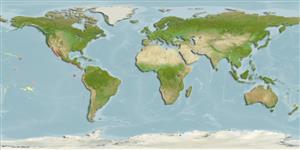>
Ophidiiformes (Cusk eels) >
Bythitidae (Livebearing brotulas)
Etymology: Grammonus: Greek, gramma = signal, mark + Greek, onos = hake.
Environment: milieu / climate zone / depth range / distribution range
นิเวศวิทยา
เกี่ยวกับทะเล,น้ำเค็ม เกี่ยวกับหินโสโครก; ระดับความลึก 6 - 18 m (Ref. 36488). Subtropical
Eastern Pacific: San Clemente Island in south California, USA to Panama and the Galapagos Islands.
ขนาด / น้ำหนัก / Age
Maturity: Lm ? range ? - ? cm
Max length : 20.3 cm TL เพศผู้/กระเทย; (Ref. 4930)
เงี่ยงครีบหลัง (รวม) : 0; ก้านครีบอ่อนที่หาง (รวม) : 95 - 115; เงี่ยงครีบก้น: 0; ก้านครีบอ่อนที่ก้น: 75 - 91; สัตว์มีกระดูกสันหลัง: 60 - 63. Branchiostegal rays: 8 (Ref. 36488).
Uncommon species (Ref. 34024). Inhabits rocky areas of shallow waters (Ref. 2850). Hides in dark caverns and crevices during the day, active at night (Ref. 2850). Gives birth to live young (Ref. 28023).
Ovoviviparous (Ref. 36488).
Nielsen, J.G., D.M. Cohen, D.F. Markle and C.R. Robins, 1999. Ophidiiform fishes of the world (Order Ophidiiformes). An annotated and illustrated catalogue of pearlfishes, cusk-eels, brotulas and other ophidiiform fishes known to date. FAO Fish. Synop. 125(18):178p. Rome: FAO. (Ref. 34024)
IUCN Red List Status (Ref. 130435)
Threat to humans
Harmless
Human uses
การประมง: ไม่มีผลประโยชน์
เครื่องมือ
Special reports
Download XML
แหล่งที่มาจากอินเตอร์เน็ต
Estimates based on models
Preferred temperature (Ref.
123201): 21.3 - 29.1, mean 26.7 °C (based on 204 cells).
Phylogenetic diversity index (Ref.
82804): PD
50 = 0.5005 [Uniqueness, from 0.5 = low to 2.0 = high].
Bayesian length-weight: a=0.00457 (0.00179 - 0.01169), b=3.10 (2.87 - 3.33), in cm total length, based on LWR estimates for this (Sub)family-body shape (Ref.
93245).
ระดับชั้นอาหาร (Ref.
69278): 3.5 ±0.50 se; based on food items.
ความสามารถในการกลับคืนสู่ปกติ (Ref.
120179): ความสูง, เวลาต่ำสุดที่จะทำให้ประชากรเพิ่มขึ้นเป็น 2 เท่าใช้เวลาน้อยกว่า 15 เดือน (Preliminary K or Fecundity.).
Fishing Vulnerability (Ref.
59153): Low vulnerability (10 of 100).
Nutrients (Ref.
124155): Calcium = 52.9 [24.3, 133.5] mg/100g; Iron = 0.662 [0.352, 1.248] mg/100g; Protein = 18 [15, 21] %; Omega3 = 0.163 [0.086, 0.306] g/100g; Selenium = 12 [5, 30] μg/100g; VitaminA = 67.1 [20.4, 228.7] μg/100g; Zinc = 0.994 [0.611, 1.562] mg/100g (wet weight);
